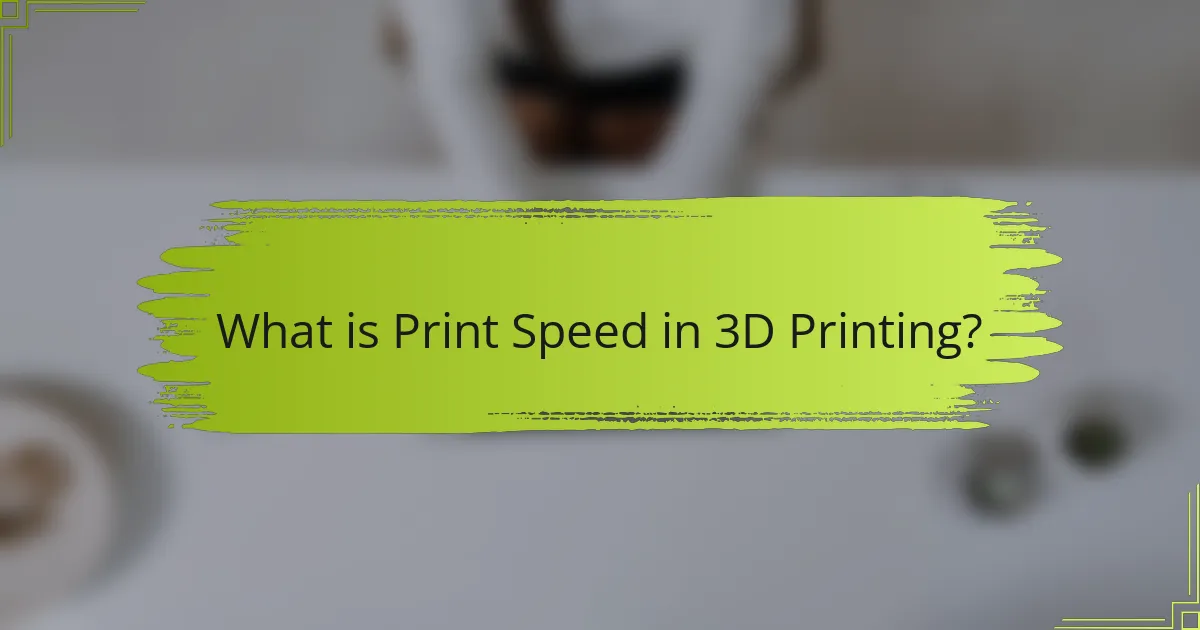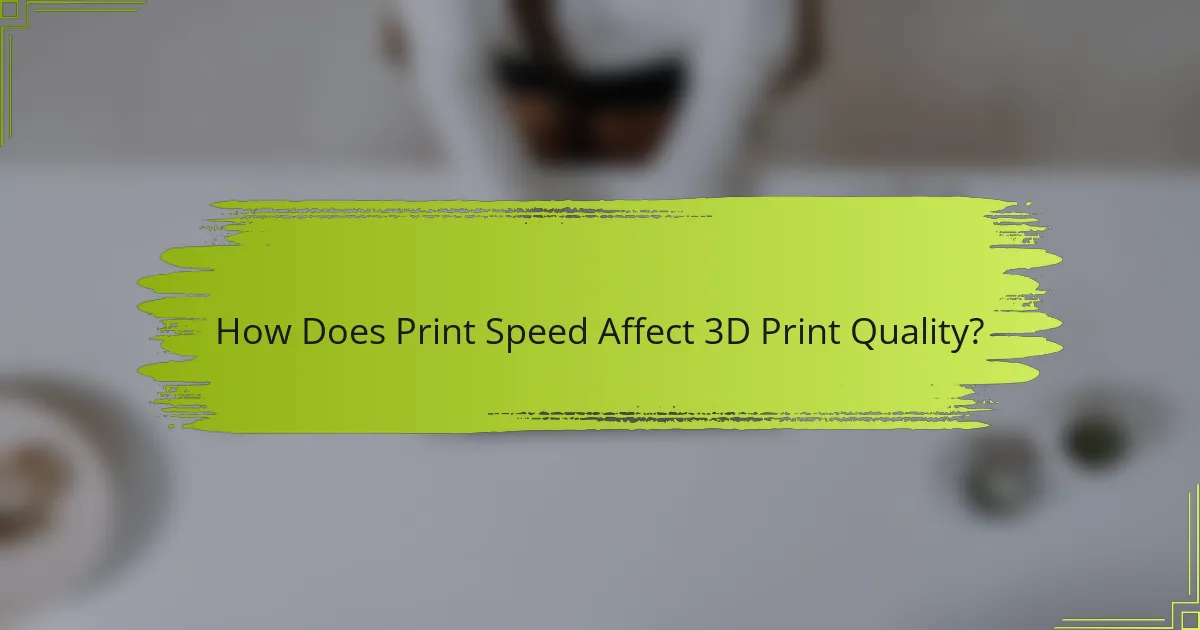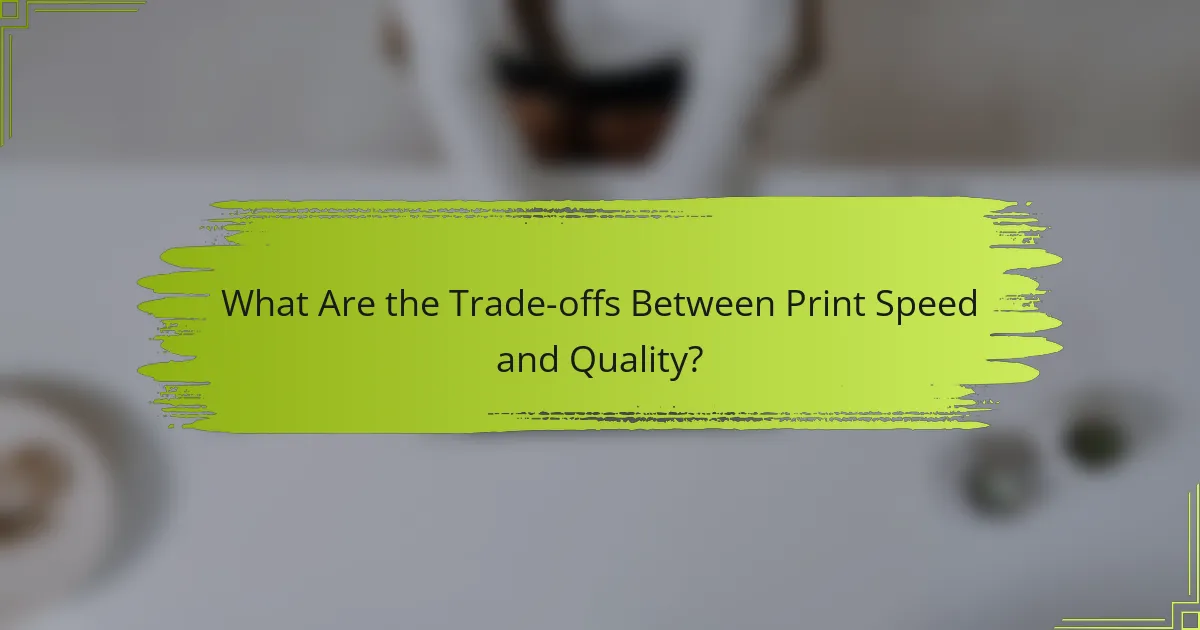
What is Print Speed in 3D Printing?
Print speed in 3D printing refers to the rate at which the printer extrudes filament to create a model. It is typically measured in millimeters per second (mm/s). Higher print speeds can reduce the time needed to complete a print. However, increasing speed may negatively impact print quality. This can lead to issues such as poor layer adhesion and reduced detail. Optimal print speed varies based on the material used and the complexity of the model. For example, PLA filament can often be printed at speeds of 60 to 100 mm/s with good results. Ultimately, finding the right balance between speed and quality is crucial for successful 3D printing.
How is Print Speed Measured in 3D Printing?
Print speed in 3D printing is measured in millimeters per second (mm/s). This metric indicates how fast the printer’s nozzle moves while depositing material. Higher print speeds can reduce the time it takes to complete a print job. However, increasing speed may also affect print quality. Factors such as layer adhesion and surface finish can deteriorate at higher speeds. Many 3D printers allow users to adjust print speed settings based on material and desired quality. Manufacturers often provide recommended speeds for different filaments. For example, PLA may print well at 50-60 mm/s, while ABS might require slower speeds to avoid warping.
What Units are Used to Express Print Speed?
Print speed is typically expressed in millimeters per second (mm/s). This unit measures how fast the printer’s nozzle moves while extruding material. It is a critical factor affecting the quality and efficiency of 3D printing. Higher print speeds can lead to faster production times but may compromise print quality. Conversely, lower speeds often yield better detail and surface finish. Manufacturers often specify optimal print speeds for their materials. Understanding these units helps users adjust settings for desired outcomes.
How Does Print Speed Vary Across Different 3D Printers?
Print speed varies significantly across different 3D printers. Factors influencing print speed include printer type, technology, and material used. Fused Deposition Modeling (FDM) printers typically have speeds ranging from 30 to 300 mm/s. Stereolithography (SLA) printers often print slower, around 20 to 100 mm/s, due to the layer curing process. Selective Laser Sintering (SLS) can achieve speeds of 10 to 50 mm/s but varies based on the complexity of the model. High-end industrial printers may exceed 500 mm/s, depending on their design and capabilities. Print speed impacts the overall print quality, with faster speeds potentially leading to issues like layer adhesion problems and reduced detail.
Why is Print Speed Important in 3D Printing?
Print speed is important in 3D printing because it directly affects production efficiency and print quality. Higher print speeds can reduce the time required to complete a project. However, excessive speeds may lead to issues such as poor layer adhesion and surface finish. Optimal print speed balances speed and quality for the best results. Studies indicate that print speeds between 30 to 60 mm/s often yield satisfactory quality without compromising structural integrity. Consistent print speeds also help maintain dimensional accuracy in the final product. Thus, understanding print speed is crucial for achieving desired outcomes in 3D printing projects.
What Impact Does Print Speed Have on Production Time?
Print speed directly affects production time in 3D printing. Higher print speeds can lead to reduced production times. This is because the printer completes layers more quickly. However, increasing print speed may compromise print quality. For instance, faster speeds can result in defects like layer misalignment. Studies show that optimal print speeds balance time and quality. A report by the Additive Manufacturing Research Group indicates that speeds above 60 mm/s often decrease dimensional accuracy. Therefore, while faster speeds reduce production time, they can negatively impact the final product.
How Does Print Speed Affect Material Usage?
Print speed significantly affects material usage in 3D printing. Higher print speeds can lead to increased material consumption due to less precise extrusion. When the print speed is too high, the printer may not deposit the filament accurately. This can result in over-extrusion, where excess material is used. Conversely, lower print speeds typically allow for more accurate material placement. This precision can reduce waste and optimize material usage. Studies indicate that optimal print speed balances speed and accuracy, minimizing excess material. For example, research shows that adjusting print speed can lead to a material usage variance of up to 20%.

How Does Print Speed Affect 3D Print Quality?
Print speed significantly affects 3D print quality. Higher print speeds can lead to reduced detail and accuracy. This occurs because the extruder may not have enough time to deposit material precisely. As a result, layers may not adhere properly. Poor adhesion can cause warping and layer separation. Conversely, slower print speeds often improve print quality. They allow for better material flow and detail retention. Research indicates that optimal speeds vary by material and printer type. For example, PLA typically prints well at 50-60 mm/s, while ABS may require slower speeds for better results.
What Are the Key Aspects of Print Quality Influenced by Print Speed?
Print speed significantly affects several key aspects of print quality. These aspects include layer adhesion, resolution, surface finish, and dimensional accuracy. Higher print speeds can lead to inadequate layer adhesion, causing weak prints. Resolution may suffer as faster speeds can limit the printer’s ability to accurately place material. Surface finish often becomes rougher at high speeds due to less time for material to settle. Dimensional accuracy can be compromised as rapid movements may lead to misalignment or warping. Research indicates that optimal print speed balances quality and efficiency, ensuring satisfactory results.
How Does Print Speed Affect Layer Adhesion?
Print speed significantly affects layer adhesion in 3D printing. Higher print speeds can lead to insufficient time for layers to bond properly. This can result in weaker adhesion and potential delamination between layers. Conversely, slower print speeds allow more time for the material to fuse. Enhanced bonding occurs when layers have adequate time to melt into each other. Studies show that optimal print speeds vary by material, impacting the quality and strength of the final print. For instance, PLA typically adheres better at moderate speeds, while ABS may require slower speeds for optimal layer bonding.
What Role Does Print Speed Play in Surface Finish Quality?
Print speed significantly affects surface finish quality in 3D printing. Higher print speeds can lead to a rougher surface finish. This occurs because the extruder has less time to deposit material evenly. In contrast, slower print speeds allow for more precise layering. This results in smoother surfaces and better detail retention. Research has shown that optimal print speeds vary by material. For example, PLA often benefits from moderate speeds for improved finish. Ultimately, balancing print speed and surface quality is crucial for achieving desired results.
What Are Common Print Speed Settings for Different Materials?
Common print speed settings vary by material. For PLA, a typical speed is 50-60 mm/s. ABS often uses a speed of 40-50 mm/s. PETG generally prints at 40-60 mm/s. TPU requires slower speeds, around 20-30 mm/s, due to its flexibility. Nylon can be printed at 30-50 mm/s. These settings help achieve optimal layer adhesion and print quality. Adjusting speeds based on material properties is essential for successful 3D printing.
How Do Material Properties Influence Optimal Print Speed?
Material properties significantly influence optimal print speed in 3D printing. Different materials exhibit varied thermal conductivity, viscosity, and tensile strength. For instance, materials with high thermal conductivity can be printed at faster speeds due to efficient heat dissipation. Conversely, materials with higher viscosity require slower speeds to ensure proper layer adhesion.
Additionally, the tensile strength of a material affects how it behaves under stress during printing. Stronger materials can endure faster print speeds without warping or breaking. A study by R. H. B. et al. in “Materials Science and Engineering” highlights that PLA can be printed at speeds up to 100 mm/s, while ABS requires slower speeds around 60 mm/s due to its properties.
These variations underscore the necessity of understanding material characteristics to determine the optimal print speed for achieving high-quality results.
What Are Recommended Print Speeds for Popular 3D Printing Filaments?
Recommended print speeds vary by filament type. For PLA, the ideal speed is typically 50-100 mm/s. ABS is best printed at 40-60 mm/s. PETG generally performs well at 30-60 mm/s. TPU, being flexible, often requires slower speeds of 20-40 mm/s. These speeds help optimize print quality and reduce issues like stringing or warping. Adjustments may be necessary based on specific printer capabilities and environmental factors.

What Are the Trade-offs Between Print Speed and Quality?
Print speed and quality in 3D printing are inversely related. Increasing print speed often leads to lower print quality. Faster speeds can result in issues like layer misalignment and poor adhesion. This happens because the extruder may not have enough time to deposit material accurately.
Conversely, slower print speeds allow for better detail and surface finish. They enable the printer to lay down material more precisely. Research shows that optimal print speeds vary by printer and material. For example, PLA typically prints well between 50-70 mm/s for quality.
In summary, prioritizing speed can compromise quality, while focusing on quality may slow down the printing process.
How Can Adjusting Print Speed Enhance Print Quality?
Adjusting print speed can significantly enhance print quality in 3D printing. Slower print speeds allow for better layer adhesion and more precise detail. This is because the extruder has more time to accurately deposit filament. Increased time also helps in achieving smoother surfaces. High speeds can lead to issues like stringing and poor layer bonding. Research shows that optimal print speeds vary by material; for example, PLA performs best at 50-60 mm/s. Ultimately, fine-tuning print speed based on specific requirements leads to improved print outcomes.
What Techniques Can Be Used to Optimize Print Speed Without Sacrificing Quality?
To optimize print speed without sacrificing quality, adjust print settings for balance. Increasing layer height can reduce print time while maintaining acceptable detail. Utilizing a larger nozzle size allows for faster extrusion, which can enhance speed. Modifying print speed settings in the slicing software can also contribute to quicker prints. Implementing proper cooling techniques ensures that the material solidifies correctly, preventing defects. Additionally, using high-quality filament can improve flow and reduce clogs, which can slow down printing. Research shows that optimizing these parameters can lead to a significant reduction in print time while preserving quality.
How Do Different Printing Techniques Impact the Speed-Quality Trade-off?
Different printing techniques significantly influence the speed-quality trade-off. Techniques like Fused Deposition Modeling (FDM) prioritize speed but may compromise detail. In contrast, Stereolithography (SLA) offers higher resolution but operates at slower speeds. Selective Laser Sintering (SLS) balances both factors, but setup time affects overall speed. Research indicates that FDM can print at speeds up to 300 mm/s, while SLA typically operates around 30 mm/h. This difference illustrates the inherent trade-offs in achieving desired quality levels. High-speed techniques often result in layer adhesion issues, affecting structural integrity. Hence, the choice of printing technique directly impacts the final print quality based on speed capabilities.
What Best Practices Should Be Followed for Optimal Print Speed?
To achieve optimal print speed, several best practices should be followed. First, ensure the printer is calibrated correctly. Calibration affects the accuracy of print movements. Second, use appropriate print settings for the material being used. Different materials have specific requirements for speed and temperature. Third, maintain a clean and well-maintained printer. Regular maintenance prevents mechanical issues that can slow down printing. Fourth, consider using higher-quality slicing software. Advanced slicers can optimize print paths and reduce time. Fifth, adjust layer height according to the desired speed. Thicker layers generally print faster but may affect detail. Lastly, minimize the number of retractions during printing. Excessive retractions can slow down the process significantly. Following these practices can enhance print speed while maintaining quality.
How Can Regular Maintenance Affect Print Speed and Quality?
Regular maintenance significantly improves print speed and quality in 3D printing. Cleaning the print head prevents clogs, which can slow down printing and degrade quality. Ensuring the build platform is level promotes consistent adhesion, reducing print failures and time loss. Regularly checking and replacing worn parts, like belts and nozzles, maintains optimal performance. Lubricating moving components reduces friction, allowing for faster movement and smoother operation. According to a study by the Journal of 3D Printing Technology, well-maintained printers produce up to 30% faster prints with higher resolution. Thus, consistent upkeep is crucial for maximizing efficiency and output quality in 3D printing.
What Tips Can Help Troubleshoot Print Speed Issues in 3D Printing?
To troubleshoot print speed issues in 3D printing, first check your printer settings. Ensure the print speed is set correctly in the slicing software. Adjusting the layer height can also improve speed. A larger layer height typically reduces print time. Inspect the filament for any tangles or blockages that may affect flow. Clean the nozzle if necessary, as clogs can slow down extrusion. Additionally, ensure the printer’s firmware is up to date for optimal performance. Finally, consider the complexity of the model; simpler designs generally print faster. These adjustments can significantly enhance print speed and overall efficiency.
Print speed is a critical factor in 3D printing that refers to the rate at which a printer extrudes filament, measured in millimeters per second (mm/s). This article examines how print speed affects various aspects of print quality, including layer adhesion, surface finish, and dimensional accuracy, while also addressing the trade-offs between speed and quality. It outlines optimal print speeds for different materials, discusses the impact of printer type on speed variations, and offers best practices for achieving a balance between efficient production and high-quality results. Additionally, it provides troubleshooting tips for common print speed issues, emphasizing the importance of regular printer maintenance.